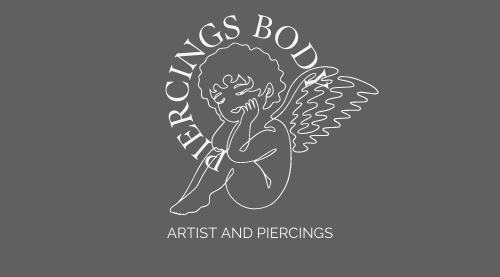Piercing and Wellness
Piercings as a Form of Reclaiming Your Body After Trauma
Step into the empowering world of piercings as a means to reclaim your body after trauma—discover how this journey can transform your healing process.
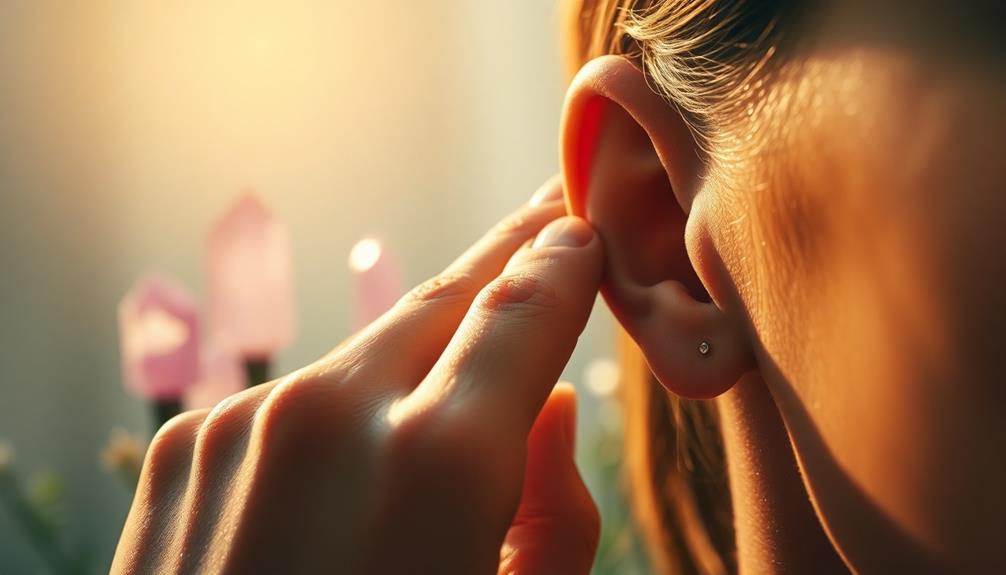
Piercings can be a powerful way to reclaim your body after trauma, offering you a sense of empowerment and control. Each piercing symbolizes a milestone in your healing journey, transforming old pain into strength. This act of body modification helps you redefine your relationship with yourself, promoting resilience and a positive self-image. By choosing to pierce your body, you assert your autonomy and express your personal identity. Many people find that working with trauma-informed professionals enhances the experience, making it more meaningful. If you're curious about how to approach this journey, there's much more to explore.
Key Takeaways
- Piercings can symbolize empowerment and autonomy, helping individuals reclaim their bodies after experiencing trauma.
- Each piercing represents a milestone in the healing journey, reinforcing resilience and personal strength.
- The process of getting pierced can transform trauma into strength through intentional body modification choices.
- Trauma-informed piercing practices create safe spaces, allowing clients to feel secure and supported during their experiences.
- Positive relationships with body parts can be cultivated through piercings, fostering a renewed sense of self.
Cultural Significance of Piercings
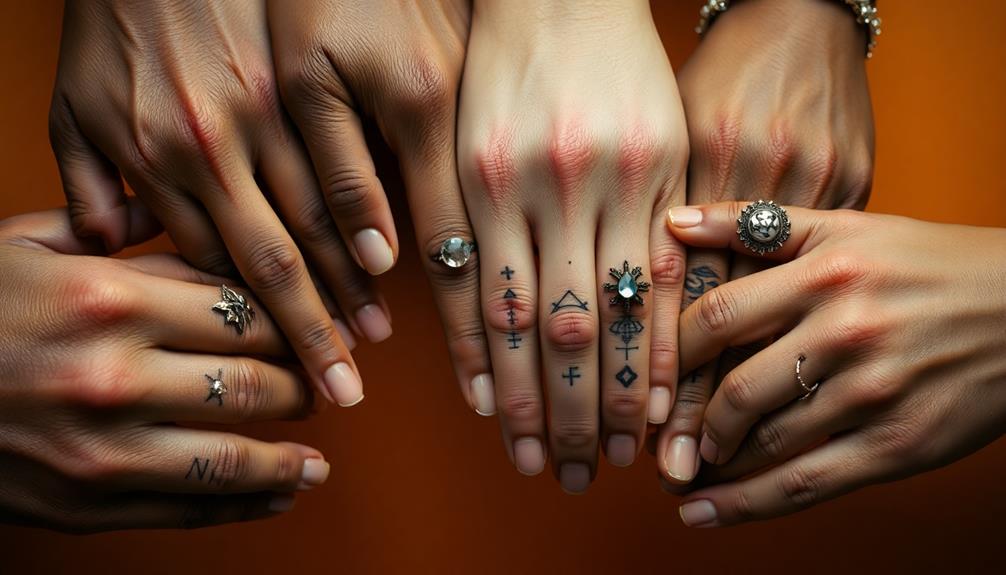
Throughout history, people have used piercings to mark significant milestones and express their identity. In various cultures, piercings serve as a rite of passage, symbolizing essential life changes like adulthood or marriage. These moments often involve cultural rituals that deepen their significance.
For many Indigenous cultures, body piercings are a powerful form of self-expression, reflecting one's identity, spirituality, and social status. The placement and style of a piercing can carry profound cultural meanings, connecting individuals to their heritage.
In modern contexts, piercings have evolved, often reflecting personal connections to subcultures. Styles like septum or facial piercings can signal affiliation with communities such as punk or goth. However, as globalization spreads specific trends, it sometimes overshadows the traditional meanings behind these practices.
Despite this, piercings continue to act as visual representations of personal values and beliefs. This allows you to assert your autonomy and express your identity within the framework of your cultural background.
Psychological Motivations for Piercing
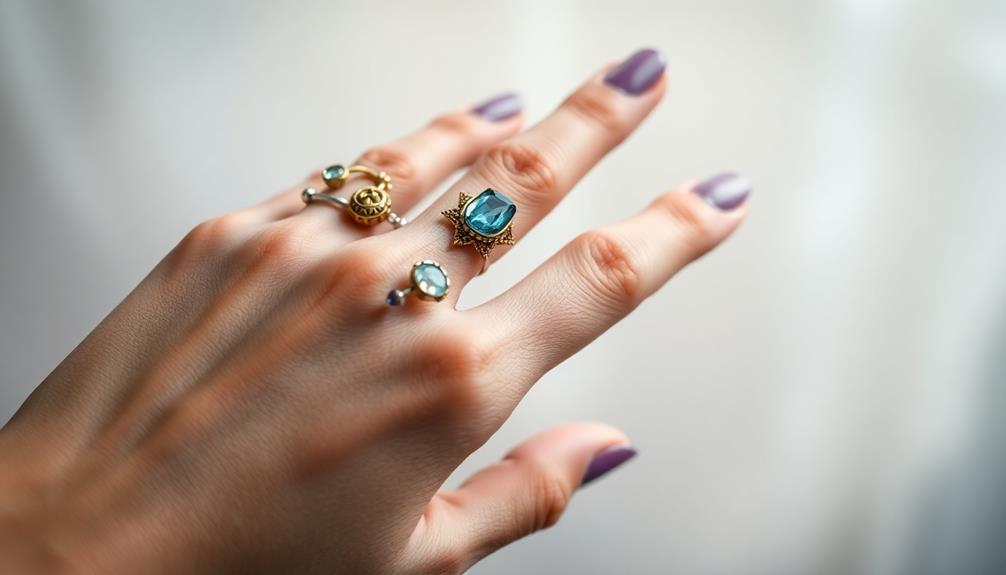
Piercing your body can be a powerful act of self-empowerment, especially for those who've faced trauma. When you choose body piercings, you declare autonomy over your own body, countering feelings of helplessness that often accompany traumatic experiences. This act can symbolize personal empowerment and reclamation, particularly for survivors of sexual assault or abusive relationships.
Research shows that individuals with a history of trauma often turn to body modifications, including piercings, as a coping mechanism for emotional pain. By engaging in this form of self-expression, you can create positive associations with body parts that once held painful memories, fostering a sense of healing and enhanced self-esteem.
Moreover, these modifications can provide a revitalizing sense of agency and freedom. You redefine your relationship with your body, transforming it into a canvas of resilience rather than a reminder of past suffering.
This journey not only aids in your mental health but also allows you to establish a new, positive identity, empowering you to move forward after experiencing trauma. Embracing body piercings can consequently be a profound step towards reclaiming your life and body.
Body Modification and Identity
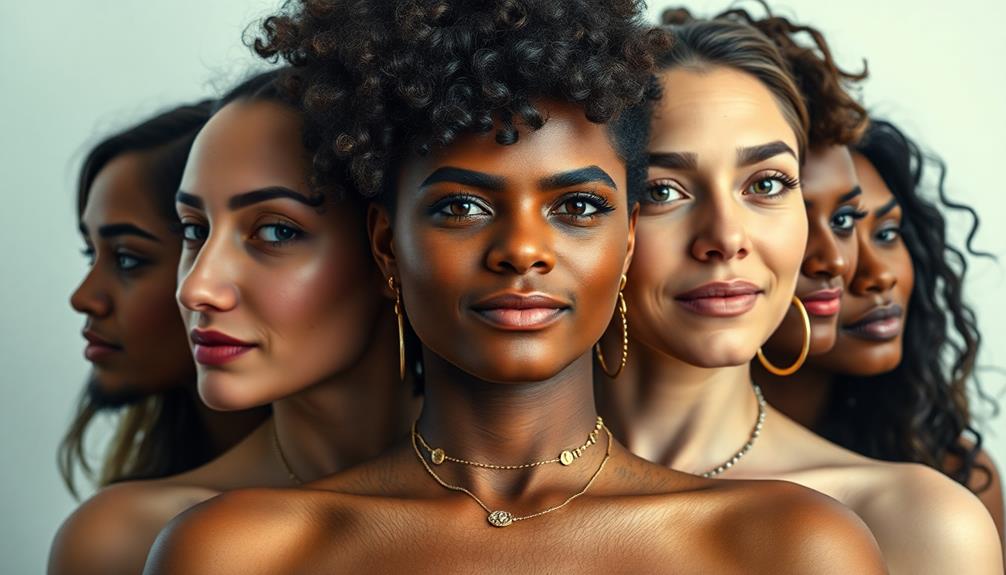
Body modification, like piercings, can empower you to reclaim your personal identity and narrative.
Each piercing can represent a milestone, reminding you of your strength and resilience after overcoming challenges.
Empowerment Through Modification
Reclaiming your body through modification can be an incredibly empowering journey, especially for those who've faced trauma. Piercings can serve as a powerful expression of your identity and resilience. When you choose to modify your body in this way, you take an active role in your healing process, celebrating milestones and transformations along the way.
This form of personal expression allows you to reclaim control over your body, which might've felt disempowering due to past experiences. Engaging in body modification can provide a sense of safety and control, which is often disrupted after experiencing abuse. Research shows that nearly half of individuals with a history of abuse have tattoos or piercings, highlighting how body modification can act as a coping mechanism. Each piercing can symbolize your journey toward autonomy and self-acceptance.
Moreover, trauma-informed piercing practices create supportive environments where your emotional significance is acknowledged, further enhancing your empowerment experience. When you engage in this process, you not only transform your body but also reclaim your narrative.
Embracing modifications like piercings fosters a sense of agency, reminding you that your body is yours to shape and define. In this way, body modification becomes not just an aesthetic choice, but a profound step toward healing.
Legal aspects of narcissistic abuse can complicate recovery, making personal empowerment through such modifications even more significant.
Reclaiming Personal Identity
For many individuals, the journey towards self-discovery often intertwines with body modification, providing a means to redefine personal identity. Piercings might serve as a form of reclaiming autonomy that was lost during traumatic experiences. When you choose to modify your body, it's an empowering act, signaling a shift towards self-acceptance and healing.
By transforming areas of your body that carry painful memories into symbols of strength, you foster a positive body image and reinforce your identity. Research indicates that many survivors of trauma turn to piercings to express resilience and reclaim parts of their identity that felt violated.
| Symbolism | Impact on Identity |
|---|---|
| Reclaiming autonomy | Enhances self-acceptance |
| Transformation of trauma | Fosters strength and agency |
| Intentional body choices | Reinforces disrupted identity |
| Sign of resilience | Marks milestones in healing journey |
| Positive body image | Encourages empowerment |
Choosing to pierce your body can mark a significant milestone, reflecting your journey towards reclaiming your identity and embracing who you truly are.
Healing Through Body Art
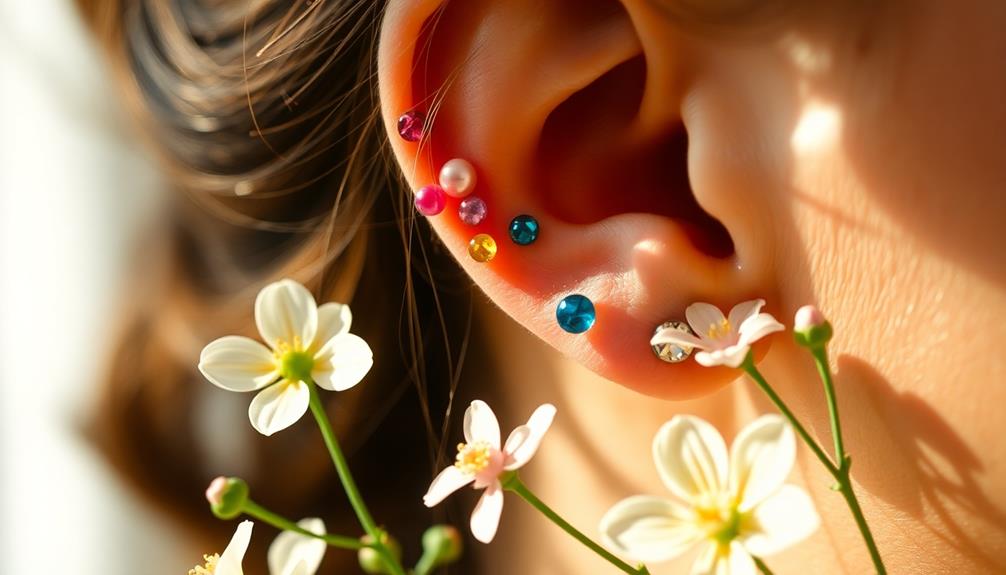
When you choose to modify your body with piercings, you're taking a powerful step toward empowerment and personal agency.
Each piercing can symbolize your resilience, marking milestones in your healing journey.
This process not only helps you reclaim control over your body but also fosters a positive relationship with your physical self.
Empowerment Through Body Modification
How can body modification, like piercings, serve as a powerful tool for personal empowerment? When you choose to modify your body, you're taking a significant step toward reclaiming your narrative and expressing your identity. Piercings can symbolize your journey, especially if you've faced trauma. Here are three ways they empower you:
- Agency and Choice: By selecting the type and location of your piercings, you assert control over your body, reclaiming a sense of freedom after experiences of restriction.
- Positive Associations: Piercings allow you to transform trauma into strength. They help you create new, empowering connections with parts of your body that may have previously felt painful or restricted.
- Supportive Environment: Professional piercers often understand the emotional complexities of body modification. They provide a nurturing space where you can express your feelings, helping you navigate the healing process.
Engaging in empowerment through body modification not only marks milestones but also facilitates a profound healing journey.
Symbolic Resilience and Healing
Through body art like piercings, you can find a powerful avenue for healing and resilience. Engaging in body modification allows you to reclaim your body after experiencing physical trauma. Each piercing can symbolize a new chapter in your life, transforming the associations you have with specific body parts. Instead of linking them to painful memories, you create new, positive connections that facilitate healing and enhance your self-confidence.
Research shows that many trauma survivors turn to piercings as a coping mechanism. This act of altering your body empowers you to express your journey and reclaim your identity. The process can evoke feelings of bravery and strength, as you actively choose to mark your transformation.
Trauma-informed practitioners recognize the emotional weight of piercings, offering supportive spaces that enhance your experience and acknowledge the complexities of body modification.
Ultimately, as you navigate your healing journey, these symbolic acts of resilience can serve as reminders of your growth. By embracing body art, you not only reclaim your physical self but also nurture your emotional well-being, paving the way for a brighter future.
Personal Agency and Control
Reclaiming agency over your body after trauma can be a profound journey, and body piercings play an essential role in that process. By choosing to engage in the piercing process, you assert control over your physical self in ways that may have felt impossible before. This choice can be particularly empowering, as certain piercings, like clitoral hood piercings, enhance self-esteem and sexual pleasure.
Here are three ways body piercings can empower you:
- Symbol of Empowerment: Each piercing can represent a personal statement of autonomy, marking a pivotal moment in your healing journey.
- Physical Control: The act of modifying your body allows you to reclaim parts of yourself that trauma may have overshadowed, fostering a sense of freedom.
- Emotional Relief: The physical pain associated with piercings can trigger endorphin release, helping to alleviate emotional distress and enhancing your healing.
Through body piercings, you can foster a positive relationship with body parts that once felt traumatic.
This journey not only promotes personal agency but also connects you deeper with your identity, allowing you to celebrate your strength and resilience. Embrace the piercing process as a powerful tool for reclaiming your body and your life.
Emotional Impact of Piercings
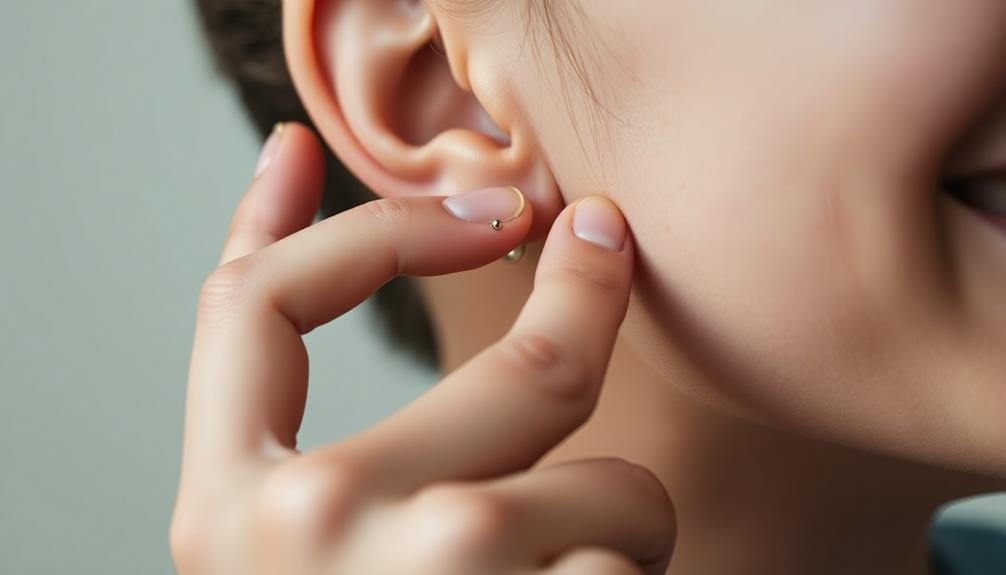
For many, the experience of getting a piercing can symbolize a significant turning point in their journey toward healing and self-empowerment. Piercings often serve as a powerful tool for reclaiming your body after trauma. This act can foster feelings of control over your physical self, transforming body parts once linked to pain into symbols of strength.
Emotional responses to piercings vary widely. While some individuals feel bravery and empowerment, others may confront more complex emotions like sadness or guilt. It is crucial to recognize that trauma-informed piercers are trained to create a supportive environment, acknowledging the emotional weight of the experience.
| Positive Emotions | Complex Emotions |
|---|---|
| Empowerment | Sadness |
| Bravery | Guilt |
| Self-confidence | Mixed feelings |
| Control over body | Reflection on trauma |
Although piercings often enhance self-image, it is important to evaluate potential risks. Understanding these emotional impacts can help you navigate your journey toward healing, ensuring that the experience is as fulfilling and supportive as possible.
Consent and Communication in Piercing
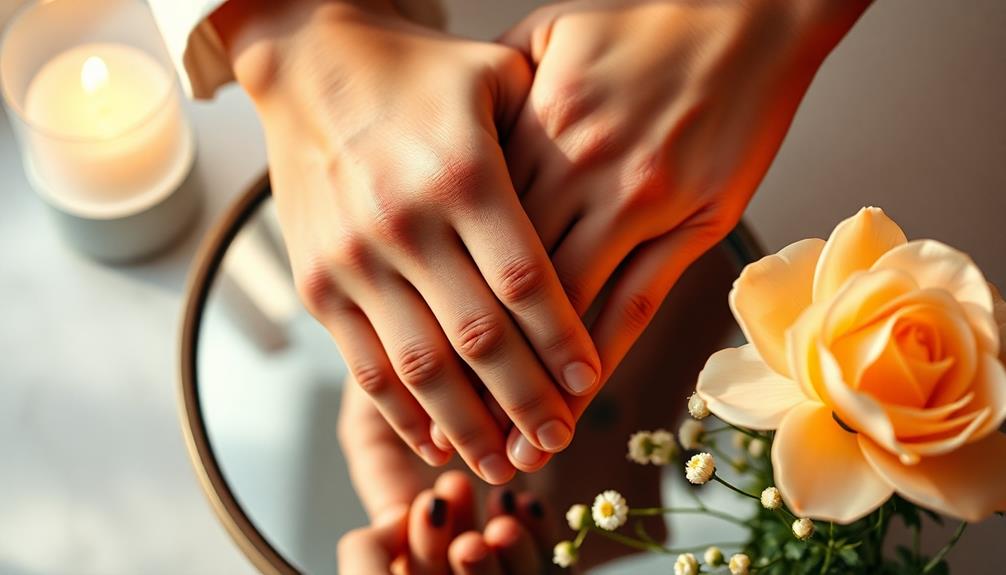
Getting a piercing is more than just a physical alteration; it's an opportunity to establish boundaries and communicate your needs. Consent is vital at every stage of the piercing process, empowering you to make informed choices. When you engage in open dialogue with your piercer, you foster a trusting environment that can promote healing.
Here are three key aspects of consent and communication in the piercing process:
- Informed Consent: Before the procedure, you should be fully briefed on what to expect. This guarantees you feel in control and secure in your decision.
- Discussing Trauma: If you have a history of trauma, your piercer should encourage you to share any specific needs or concerns. This open communication allows them to tailor the experience to your comfort level.
- Post-Piercing Support: Continuous communication after your piercing is essential. It allows you to express your feelings and receive support, reinforcing the bond you share with your piercer throughout your healing journey.
Trauma-Informed Piercing Practices
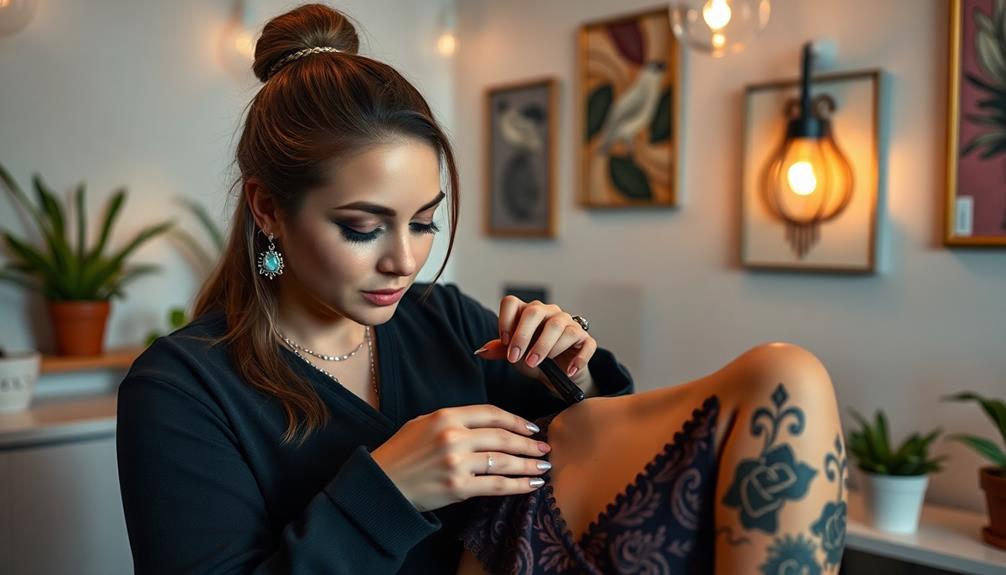
Creating a safe space is essential in trauma-informed piercing practices, as it acknowledges the deep impact trauma can have on your healing journey. A skilled practitioner understands that every client's history is unique and may have lingering effects on their emotional and physical well-being. They receive specialized training to recognize signs of trauma and implement strategies to prevent re-traumatization during your experience.
Consent is a central tenet of trauma-informed piercing. Your comfort and empowerment are prioritized at every stage, guaranteeing you feel informed and in control. This fosters trust between you and the piercer, creating an environment where you can express your needs and boundaries openly.
After the piercing, practitioners are aware that emotional responses can vary widely, from feelings of empowerment to unexpected sadness. They remain available for ongoing communication and support, helping you navigate any feelings that may arise.
Many trauma-informed piercers engage in continuous education, enhancing their understanding of trauma and its implications, which guarantees a high standard of care for you. Ultimately, these practices aim to honor your journey and help you reclaim your body in a safe, supportive manner.
Personal Stories of Reclamation
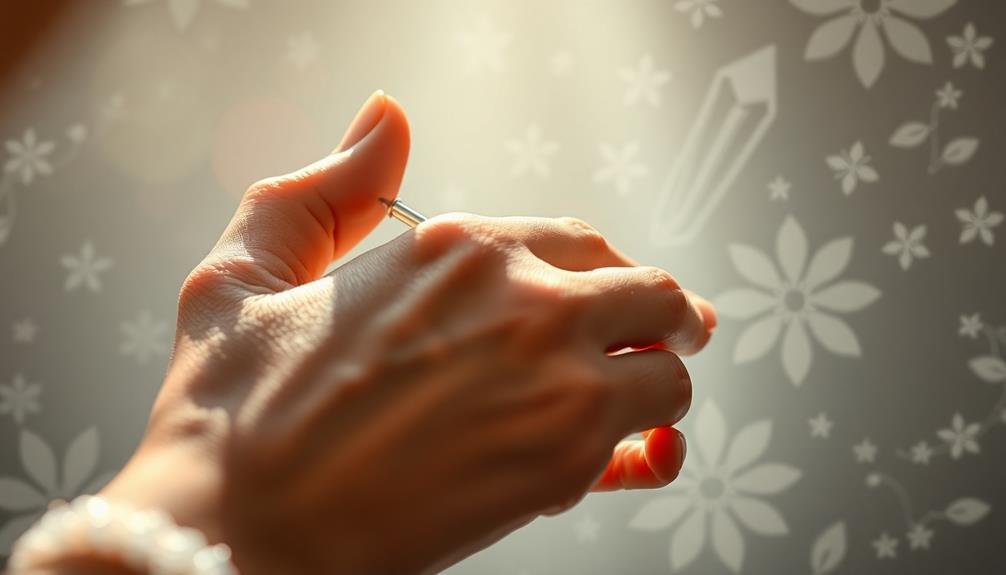
Many survivors find that personal stories of reclamation often intertwine with their experiences in trauma-informed piercing settings. You might hear how getting their ears pierced becomes a pivotal moment in someone's healing journey, symbolizing a choice they take back for themselves.
These narratives highlight the power of body modification to transform trauma into resilience.
Here are three common themes in these stories:
- Empowerment: Many individuals describe how the act of choosing a piercing empowers them, allowing them to reclaim agency over their bodies that may have felt violated.
- Milestones of Healing: Survivors often celebrate significant life changes through piercings, marking their journey of recovery and resilience. Each new piercing serves as a reminder of their strength.
- Reconnection with the Body: For some, piercings create new, positive associations with parts of their bodies that carry painful memories. This transformation fosters feelings of confidence and ownership.
Ultimately, personal experiences in the piercing industry reveal how body modification acts as a coping mechanism, allowing survivors to express their strength and celebrate their recovery.
Resources for Survivors and Practitioners
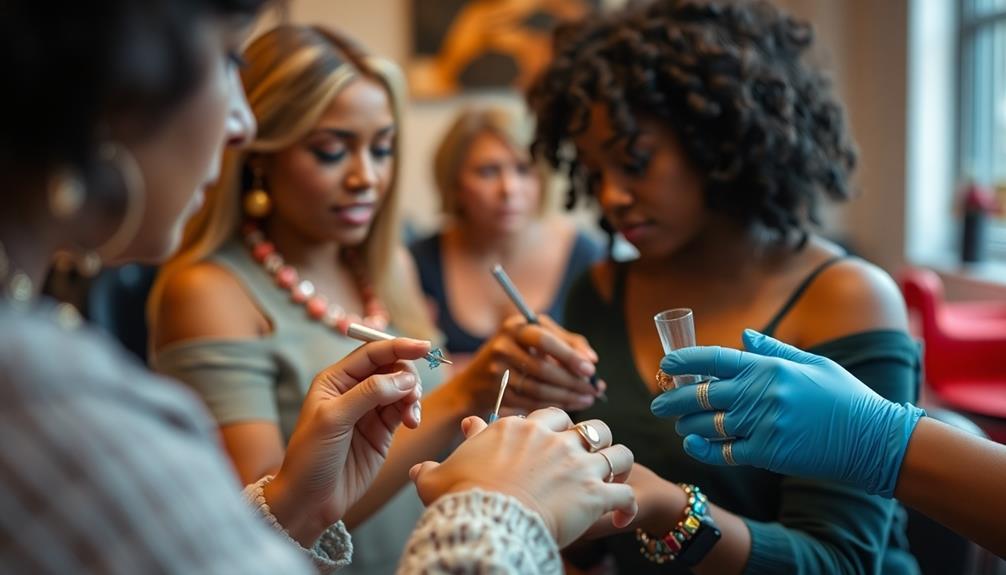
Accessing resources tailored for survivors and practitioners can greatly enhance the experience of trauma-informed piercing. Many piercers now offer trauma-informed services, designed to create a supportive atmosphere for clients who've experienced trauma. You'll notice practitioners often display certifications indicating their commitment to understanding your unique needs.
As a survivor, you can seek out resources like peer support groups or literature that shares personal experiences and healing journeys. These resources for survivors promote community and understanding, helping you feel less isolated in your journey.
Additionally, networking among trauma-informed practitioners guarantees they share best practices and ongoing education, which translates to more informed and compassionate care for you.
Feedback from clients is essential; it helps practitioners adapt their approaches and improve your overall experience. By voicing your thoughts, you contribute to a growing body of knowledge that supports others who may be steering through similar paths.
When you choose a piercer who prioritizes trauma-informed services, you're not just reclaiming your body—you're also engaging with a community dedicated to healing and understanding. Together, these resources can empower you and practitioners alike in the journey of reclamation and healing.
Frequently Asked Questions
Is Getting Piercings a Coping Mechanism?
Getting piercings can be a coping mechanism for many. You might find that altering your body helps you express emotions, regain control, or simply feel more comfortable in your skin, providing a sense of empowerment.
What Does Psychology Say About Piercings?
What do you think piercings symbolize? Psychology highlights that they can represent self-expression and autonomy, often linked to identity and emotional healing, allowing you to assert control and transform your relationship with your body.
How to Connect With Your Body After Trauma?
To connect with your body after trauma, try mindful practices like meditation or yoga. Focus on your breath, engage in gentle movement, and nurture self-compassion—these actions can cultivate awareness and promote healing in your physical self.
What Do Piercings Symbolize?
Piercings symbolize both pain and beauty. They reflect your journey, showcasing your individuality and strength. Every piercing tells a story, reminding you of your choices, your identity, and the power you hold over your body.
Conclusion
In reclaiming your body through piercings, you're not just altering your appearance—you're crafting your narrative. Each piece of jewelry tells a story of resilience and empowerment, turning pain into art. Remember, your body is your canvas, and you hold the brush. By embracing this form of self-expression, you're not only healing but also celebrating your journey. So, go ahead and adorn yourself; let your piercings shine as symbols of your strength and survival.
Hi, my name is Danielle, and I’m an author for piercings-body.com. I have a passion for writing and love to share my knowledge on all things body piercing-related. I’m also a huge advocate for safe body modification practices and believe everyone should be able to make informed decisions about their bodies. When I’m not writing or blogging, I enjoy spending time with my family and friends, practicing yoga, and exploring new places.
Piercing and Wellness
Mindfulness and Body Modification: Finding Balance
Transform your approach to body modification by discovering how mindfulness can align your changes with your true self—unlock the secrets to lasting fulfillment.
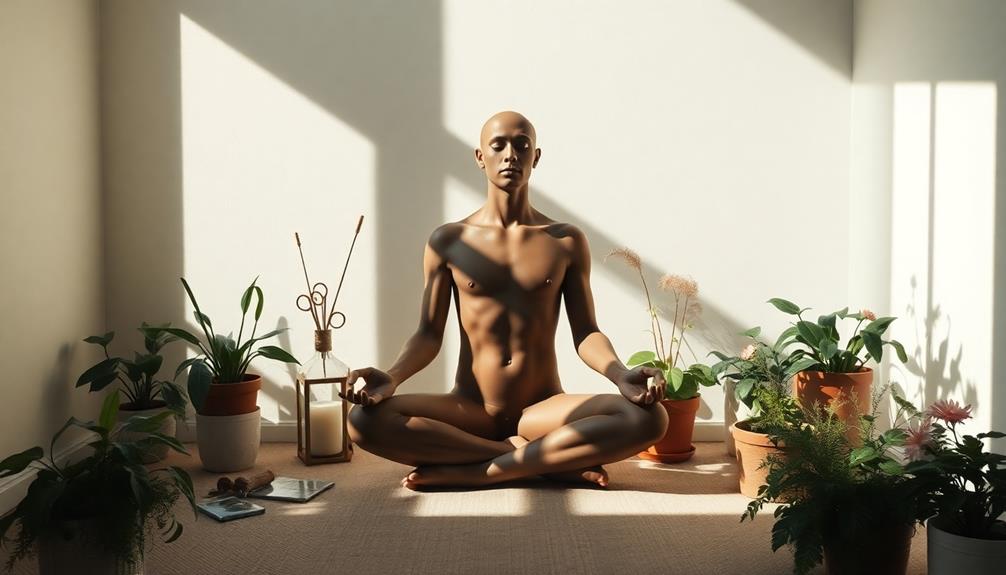
Mindfulness helps you find balance in body modification by fostering intentional choices that reflect your true self. It encourages self-awareness and emotional regulation, enabling you to connect deeply with your motivations for change. By practicing mindful techniques, like journaling or yoga, you enhance your emotional clarity and understand personal values better. This way, your modifications can empower your self-image and symbolically mark significant transformations. Embracing a mindful approach guarantees that your body changes align with your inner values, leading to greater satisfaction. Discover how to integrate mindfulness further into your journey for lasting emotional well-being and a sense of fulfillment.
Key Takeaways
- Mindfulness enhances emotional awareness, aiding individuals in making conscious decisions about body modifications that align with their true selves.
- Engaging in mindful practices, such as journaling, helps clarify personal values and desires related to body image and modification choices.
- A mindful approach to body modification promotes self-acceptance, boosting body positivity and emotional well-being throughout the transformation process.
- Incorporating mindful movement, such as yoga, connects physical sensations with mental awareness, fostering a harmonious relationship between body and mind during modifications.
- Regular self-reflection through mindfulness practices ensures that body modifications reflect evolving values and contribute positively to overall life balance.
Understanding Mindfulness

Mindfulness is more than just a buzzword; it's a powerful mental practice that helps you stay aware of the present moment. By focusing on your thoughts and feelings moment by moment, you can cultivate a deeper connection with yourself and your surroundings.
This practice promotes emotional regulation and reduces stress, allowing you to navigate daily challenges with greater ease. Incorporating mindfulness into activities like yoga can further enhance this connection, providing both mental and physical benefits as you engage in mindful movement yoga for back pain.
Regular mindfulness practices, like mindful breathing and mindful movement, enhance your self-awareness and improve concentration. As you engage in these activities, you'll notice better decision-making and increased emotional resilience.
For instance, when you practice mindful eating, you savor each bite, fostering a stronger connection with your body's cues and encouraging healthier eating habits.
You can also transform mundane experiences into opportunities for mindfulness. Whether you're commuting or doing chores, incorporating mindfulness into these activities can lead to greater awareness and tranquility.
The benefits are numerous, including lower blood pressure and improved sleep quality. By embracing mindfulness, you enhance your overall well-being, making each moment more meaningful and enriching.
The Role of Body Modification

Body modification plays a significant role in how people express their identities and enhance their self-image. Whether it's a tattoo, piercing, or surgical alteration, these practices allow you to communicate your individuality and personal journey. The global tattoo market, valued at around $3 billion in 2020, illustrates a growing acceptance of body art, reflecting a shift towards normalization.
Engaging in body modification can be particularly empowering, especially for those recovering from gaslighting in relationships, as it offers a way to reclaim agency over one's body and identity.
When you engage in body modification, you might find that it can boost your body positivity and self-esteem. Many individuals report feeling more confident and empowered after making such changes. These modifications often serve as rituals of personal transformation, symbolizing key life events or changes that are meaningful to you.
Approaching body modification mindfully is essential for finding balance. When you consider your motivations, the emotional implications, and the potential impact on your mental health, you can create a more fulfilling experience.
Research suggests that mindful engagement in body modification can enhance emotional regulation and resilience. By taking the time to reflect on your choices, you guarantee that your modifications align with your true self, leading to a deeper sense of satisfaction and balance in your life.
Benefits of Mindfulness Practices

Engaging in mindfulness practices can greatly enhance your emotional well-being, especially when paired with body modification. By focusing on the present moment, you develop emotional regulation skills that help manage stress and anxiety.
You'll find that as you practice mindfulness, you become more self-aware, allowing you to respond thoughtfully to challenging situations.
Regularly practicing mindful breathing techniques can lower your blood pressure and promote relaxation. When you feel overwhelmed, simply pause and bring your attention back to your breath. This act calms your nervous system, creating a space for clarity and peace.
Mindful eating is another powerful tool. As you savor each bite, you'll enhance your digestion and become attuned to your body's hunger and fullness cues.
Additionally, incorporating mindful movement, like nature walks or gentle stretching, can boost your focus and reduce anxiety, helping you connect with your body on a deeper level.
Cultivating Emotional Awareness

Emotions are like a compass, guiding you through life's ups and downs. Cultivating emotional awareness is essential for maneuvering through these feelings effectively, and it aligns closely with the principles of positive thinking found in our book.
By developing this awareness, you can improve your emotional regulation and build resilience against stressors, ultimately enhancing your mental well-being and fostering personal growth through research-backed content.
Here are three effective strategies to enhance your emotional awareness:
- Mindful Breathing: Focus on the rhythm of your breath. This practice helps you observe your emotions non-judgmentally, reducing reactivity and allowing you to recognize feelings as they arise.
- Journaling: Write about your emotions regularly. This not only deepens self-awareness but also helps you identify patterns in your emotional responses, promoting healthier coping mechanisms.
- Mindful Movement: Engage in activities like yoga or tai chi. These practices foster a stronger connection between your body and emotional states, enhancing your overall awareness.
Balancing Body and Mind

Finding harmony between your mental and physical states is essential for overall well-being. To achieve this balance, you need to bring your attention to consistent practices like mindfulness. Engaging in mindful movement, such as yoga or tai chi, creates a powerful connection between your physical sensations and mental awareness, promoting holistic health.
Incorporating aromatherapy benefits into your routine can further enhance relaxation and emotional regulation, helping you to manage stress more effectively.
Incorporating mindful breathing techniques can also enhance your focus and clarity. As you navigate daily challenges, these techniques allow you to manage both physical and mental demands more effectively.
Additionally, maintaining a healthy diet and exercise routine is vital; they directly influence your mental health by reducing symptoms of anxiety and depression.
Don't overlook the value of self-reflection through mindful journaling. This practice encourages you to analyze your thought patterns and emotional responses, helping you integrate both body and mind into a harmonious state.
Spiritual Growth Through Mindfulness

Mindfulness not only enhances the connection between your body and mind but also serves as a pathway for spiritual growth. By engaging in mindfulness practices, you can deepen your relationship with your inner self and the world around you.
As you cultivate awareness, you may experience signs of high spiritual energy, such as increased intuition and clarity, which can guide your journey toward self-discovery and fulfillment recognizing spiritual energy.
Here are three ways mindfulness fosters spiritual growth:
- Cultivating Compassion: Loving-kindness meditation helps you develop compassion for yourself and others, essential for emotional well-being and spiritual development.
- Building Resilience: Regular mindfulness practice strengthens your ability to cope with negative emotions. This resilience allows you to face life's challenges with a balanced spiritual perspective.
- Encouraging Self-Reflection: Mindfulness promotes continuous self-reflection, leading to personal growth and a clearer understanding of your purpose and values.
As you become more aware of your thoughts and emotions, you can release negative patterns that hinder your spiritual journey.
This awareness nurtures a harmonious connection to your spiritual self, enabling you to navigate life's complexities with grace.
Embrace mindfulness as a tool for spiritual growth, and watch how it transforms your understanding of yourself and your place in the universe.
Integrating Mindfulness Into Daily Life
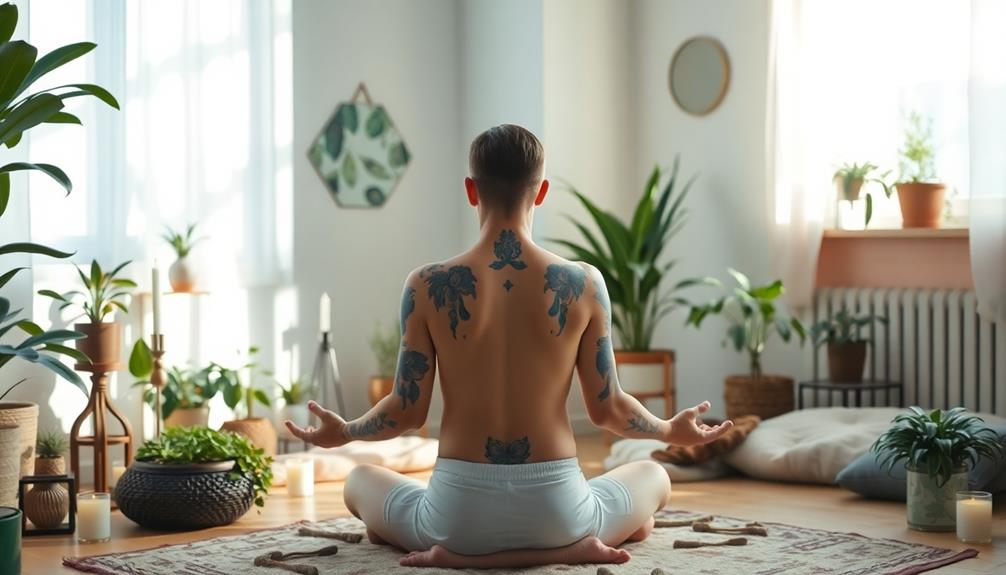
You can easily integrate mindfulness into your daily routine by setting reminders that prompt you to pause and breathe.
Mindful journaling can also help you reflect on your experiences, boosting your self-awareness and personal growth.
Daily Mindfulness Reminders
Incorporating mindfulness into your daily life can be as simple as taking short, intentional breaks throughout the day. These moments can greatly reduce stress and improve your focus.
To help you integrate mindfulness seamlessly, consider these daily reminders:
- Set Alarms: Choose specific times during your day to pause and breathe deeply. An alarm can serve as a gentle nudge to check in with yourself.
- Sticky Notes: Place sticky notes with motivational quotes or reminders in visible areas, like your workspace or bathroom mirror. They'll prompt you to be present and mindful throughout the day.
- Mindful Activities: Engage in simple, everyday actions mindfully, whether it's savoring your meals or enjoying a nature walk. These practices can make mindfulness a natural part of your daily routine.
Mindful Journaling Benefits
Journaling offers a powerful way to deepen your mindfulness practice by providing a space for self-reflection and emotional processing. Additionally, it can help you in resetting and recovering from distress, allowing you to identify core issues that may be affecting your mental health.
Another important benefit of mindful journaling is its ability to enhance your emotional regulation and resilience. By regularly engaging in this practice, you can better understand your feelings and thoughts, leading to increased self-awareness. This awareness allows you to identify patterns in your behavior, helping you navigate challenges more effectively.
Research shows that writing about your thoughts and feelings can markedly reduce stress and anxiety, promoting better mental well-being. As you pour your emotions onto the page, you create a safe outlet for processing experiences that might otherwise overwhelm you.
Additionally, mindful journaling can serve as a tool for gratitude. By focusing on positive experiences, you cultivate a sense of appreciation in your daily life.
Integrating mindful journaling into your routines creates a consistent practice that reinforces mindfulness. This practice not only helps you process emotions but also contributes to overall life balance.
Exploring Personal Values and Desires
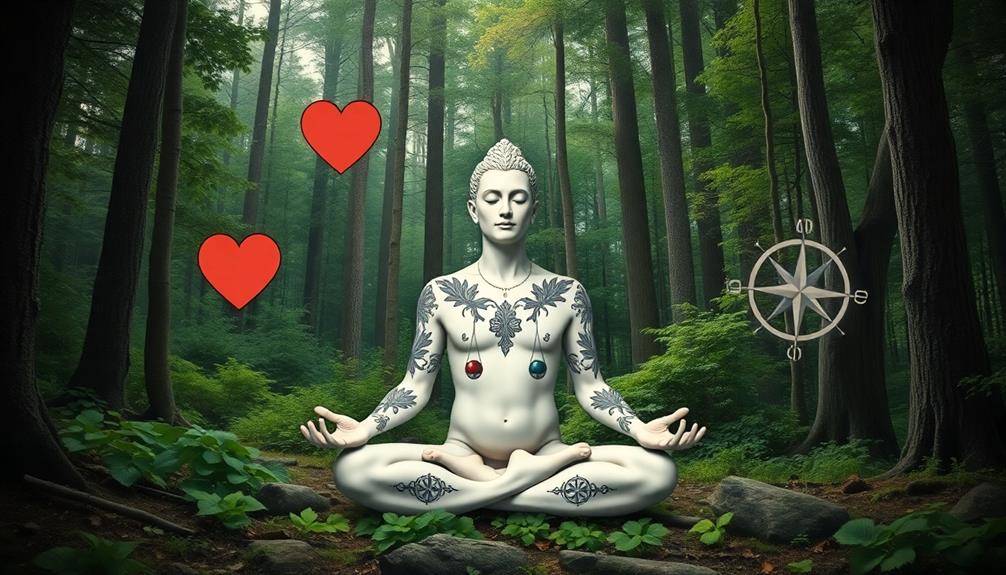
When you think about body modification, it's important to identify what truly matters to you.
Understanding your core values and desires can guide your choices, helping you align your actions with what reflects your identity.
Identifying Core Values
Identifying your core values is essential for making authentic life choices, especially when it comes to body modification. Your values serve as a foundation for the decisions you make, ensuring they align with your true self.
Reflecting on what's truly important to you can lead to greater satisfaction and self-esteem. Engaging in practices like mindfulness can enhance your ability to connect with your inner self and align with your emotional well-being.
Here are three important parts to help you identify your core values:
- Reflect: Take time to think about your beliefs and principles. What matters most to you? Consider your experiences and how they've shaped your values.
- Engage in Mindfulness: Practices like journaling or meditation can help you explore your feelings without judgment. This clarity can make it easier to understand what you truly desire.
- Reassess Regularly: Life changes, and so might your values. Regularly affirming your core beliefs can help you navigate the emotional impacts of body modification, ensuring that your choices reflect genuine self-expression.
Understanding Personal Desires
Many people find that understanding their personal desires is a transformative journey that deepens their sense of self. This process involves reflecting on your core values, beliefs, and motivations that drive your choices and behaviors.
Engaging in mindfulness practices enhances your self-awareness, helping you identify and articulate true desires that often get tangled in societal expectations. Incorporating mindfulness practices can further support your journey by reducing emotional eating and promoting a balanced approach to your goals.
As you explore understanding personal desires, consider what truly motivates you: Is it the need for connection, achievement, or self-expression? Journaling or meditation can be powerful tools for uncovering these intrinsic motivations.
Recognizing the difference between fleeting desires and deeply held values is vital. This distinction is significant for making meaningful choices that resonate with your authentic self.
Cultivating a compassionate mindset towards your desires fosters acceptance and encourages a balanced approach to pursuing your goals. Embrace this journey with curiosity, allowing yourself to explore what genuinely matters to you.
Aligning Actions With Values
Understanding your personal desires sets the stage for aligning your actions with your values. When you identify what truly matters to you, you can make conscious decisions that reflect your authentic self. This alignment leads to greater fulfillment and happiness.
To effectively bring your attention back to your core values, consider these steps:
- Reflect: Engage in journaling or meditation to clarify your intrinsic values—like personal growth and relationships—over extrinsic ones, such as material success or social approval.
- Prioritize: Once you've identified your values, prioritize actions that reflect them. This helps you make meaningful choices that resonate with your true self.
- Reassess: Regularly review and adjust your goals and actions. As your values evolve, staying adaptable will foster resilience and guarantee your life remains aligned with what matters most.
Embracing Change With Intention

While commencing a journey of body modification, you'll find that embracing change with intention can greatly shape your experience.
Setting clear goals and understanding your motivations provides you with a sense of purpose and clarity throughout the process. When you're mindful about your choices, you're less likely to feel uncertain or regretful. Incorporating techniques from the Law of Attraction in sports can enhance your mindset, helping you visualize your desired outcomes more effectively.
Engaging in mindful practices enhances your self-awareness, allowing you to connect deeply with your feelings about the changes you're making.
Research shows that those who approach body modification with mindfulness report greater satisfaction and emotional well-being afterward. This connection helps you align your actions with your intentions, making the shift smoother.
Frequently Asked Questions
How Is Mindfulness Connected to Balance?
Mindfulness helps you recognize and understand your emotions and physical sensations, allowing you to identify imbalances in your life. By staying present, you can make healthier choices and maintain a more balanced, fulfilling existence.
How to Find Balance Between Mind and Body?
To find balance between mind and body, you'll embrace stillness while moving, savor meals yet listen to hunger, and reflect on feelings while engaging in joyful activities. It's about harmony, not perfection.
How Does Mindfulness Help With Work Life Balance?
Mindfulness helps you manage stress and improve focus, making it easier to separate work from personal life. By practicing mindfulness regularly, you'll enhance your emotional regulation and resilience, ultimately achieving a healthier work-life balance.
How to Get a Balanced State of Mind?
To achieve a balanced state of mind, practice mindfulness techniques like meditation and breathing exercises. Engage in physical activities you enjoy, keep a gratitude journal, and regularly reflect on your thoughts to enhance self-awareness.
Conclusion
In your journey of balancing mindfulness and body modification, remember that both practices can enhance your sense of self. Visualize your mind as a calm lake, reflecting your physical changes like ripples on the surface. Each mindful moment deepens your emotional awareness, while intentional body modifications express your evolving identity. Embrace this harmony, allowing your values and desires to guide you. Together, they create a powerful synergy that fosters spiritual growth and personal transformation.
Hi, my name is Danielle, and I’m an author for piercings-body.com. I have a passion for writing and love to share my knowledge on all things body piercing-related. I’m also a huge advocate for safe body modification practices and believe everyone should be able to make informed decisions about their bodies. When I’m not writing or blogging, I enjoy spending time with my family and friends, practicing yoga, and exploring new places.
Piercing and Wellness
The Role of Piercings in Gender Expression and Identity
See how piercings serve as powerful symbols of gender identity and expression, revealing deeper connections within the LGBTQ+ community.
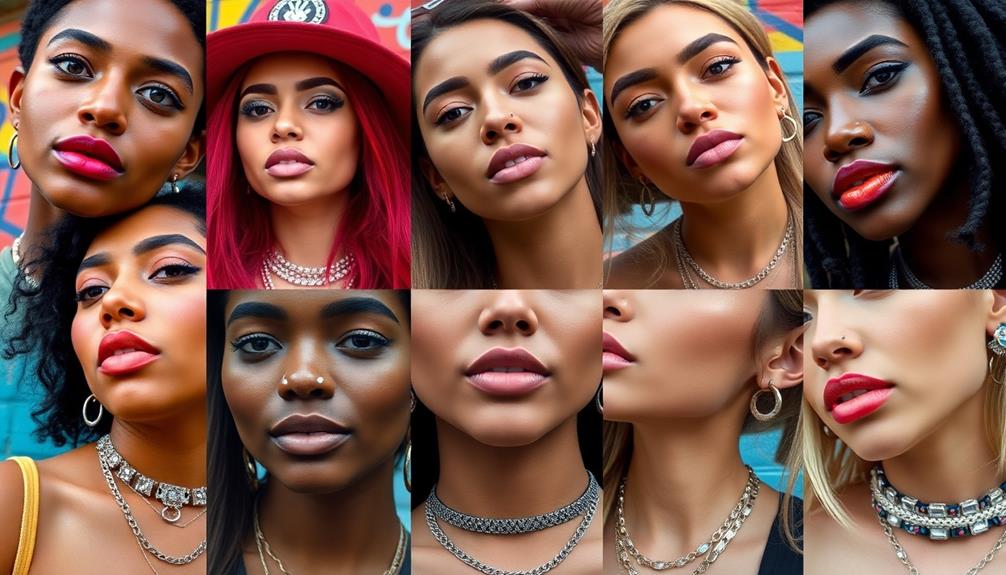
Piercings are essential for expressing and shaping your gender identity. They symbolize autonomy and challenge societal norms. By choosing specific locations or LGBTQ+ themed jewelry, you can communicate pride and solidarity. Many people use piercings as a way to mark personal milestones, enhancing self-acceptance and body image. For transgender and non-binary individuals, piercings can alleviate dysphoria and provide a sense of belonging. Plus, they foster connections within the community, reinforcing shared experiences and identities. If you're curious about how piercings impact personal journeys and community dynamics, there's much more to explore.
Key Takeaways
- Piercings symbolize autonomy and challenge traditional gender norms, allowing individuals to express their unique identities.
- Specific piercings and LGBTQ+ themed jewelry communicate solidarity and enhance visibility within the community.
- For transgender and non-binary individuals, piercings can alleviate dysphoria and reinforce body acceptance.
- The act of getting pierced symbolizes control over one's body, contributing to improved self-esteem and body image.
- Shared experiences of piercings foster community bonding and inclusivity among individuals navigating their gender identities.
Piercings as Identity Symbols
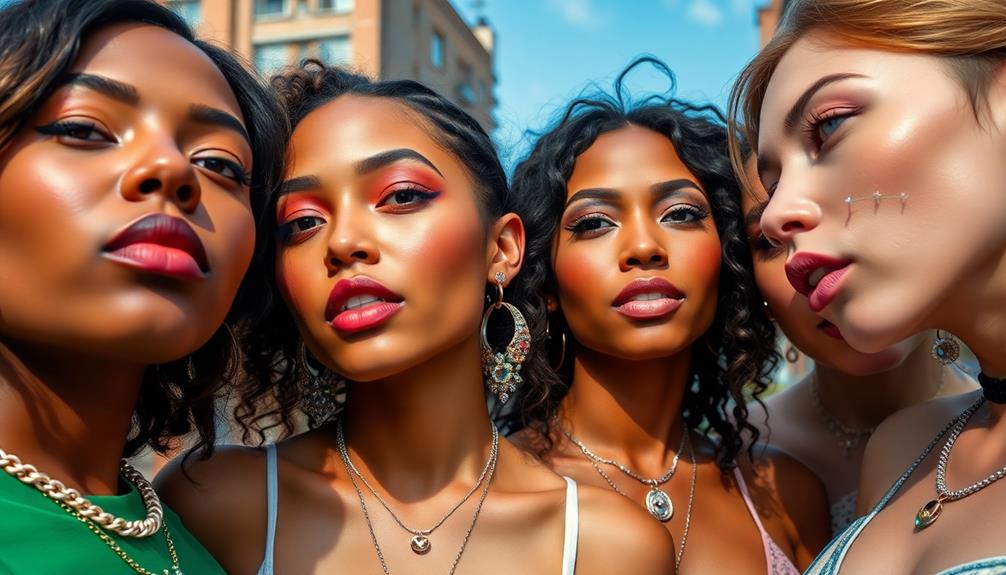
Expressing yourself through piercings can be a powerful way to assert your identity, especially within the LGBTQ+ community. Piercings serve as compelling symbols of autonomy, allowing you to challenge societal norms around gender and sexuality. By choosing specific locations for your piercings and adorning them with LGBTQ+ themed jewelry, like rainbow colors, you communicate solidarity and pride in your unique identity.
It's important to recognize that non-intimate piercings are just as valid as intimate ones. Each piercing you choose represents a form of expression that reflects your journey and challenges misconceptions about what body modification means. Often, the act of getting pierced is tied to personal milestones, marking significant transformations in your life and your understanding of gender identity.
Moreover, piercings can foster community bonding among those who share similar experiences. They help reinforce a collective identity that celebrates diversity and inclusion within the LGBTQ+ community. By wearing your piercings proudly, you not only express your individuality but also connect with others who appreciate and honor the rich tapestry of identities that make up this vibrant community.
Cultural Context and Significance
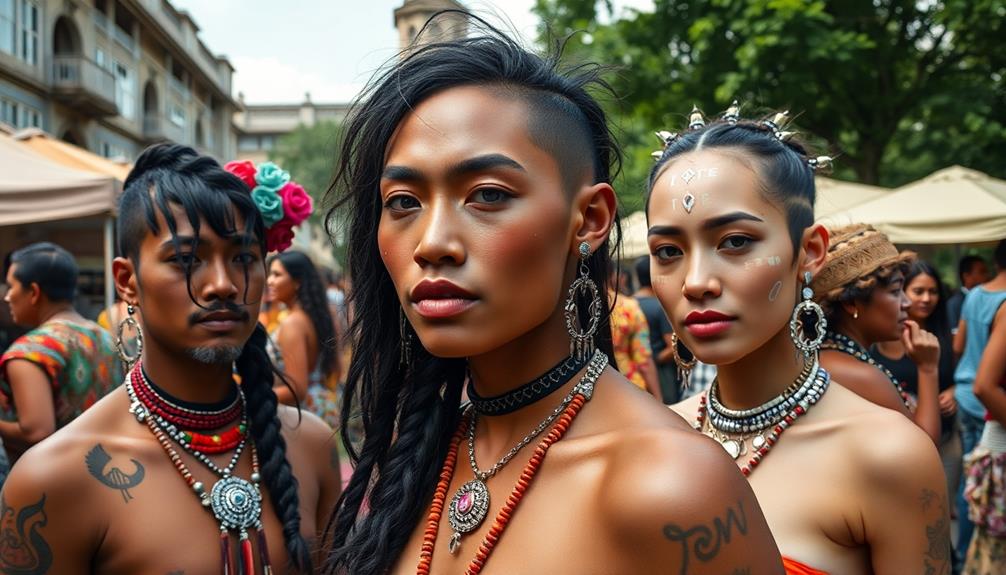
Throughout history, piercings have transcended mere body modification, solidifying their place as crucial markers of identity within queer, trans, and kink communities.
For many, piercings serve as crucial tools for self-expression and identity affirmation, pushing back against traditional societal norms. They allow individuals to reshape their identities and assert their presence in a world that often marginalizes difference.
Consider these significant aspects of piercings in cultural contexts:
- Identity Signaling: The "gay ear" phenomenon illustrates how piercings can discreetly communicate one's sexual orientation, reflecting evolving cultural codes.
- Resistance and Empowerment: Piercings have historically symbolized resistance against societal norms, allowing marginalized communities to assert their gender expression and individuality.
- Gender Affirmation: For transgender and non-binary individuals, piercings can alleviate dysphoria, enhance body acceptance, and serve as a physical manifestation of their gender identity.
As societal attitudes toward queer people shift, the integration of piercings into their culture continues to evolve, impacting visibility, acceptance, and safety in expressing one's authentic self.
Psychological Impacts of Piercings
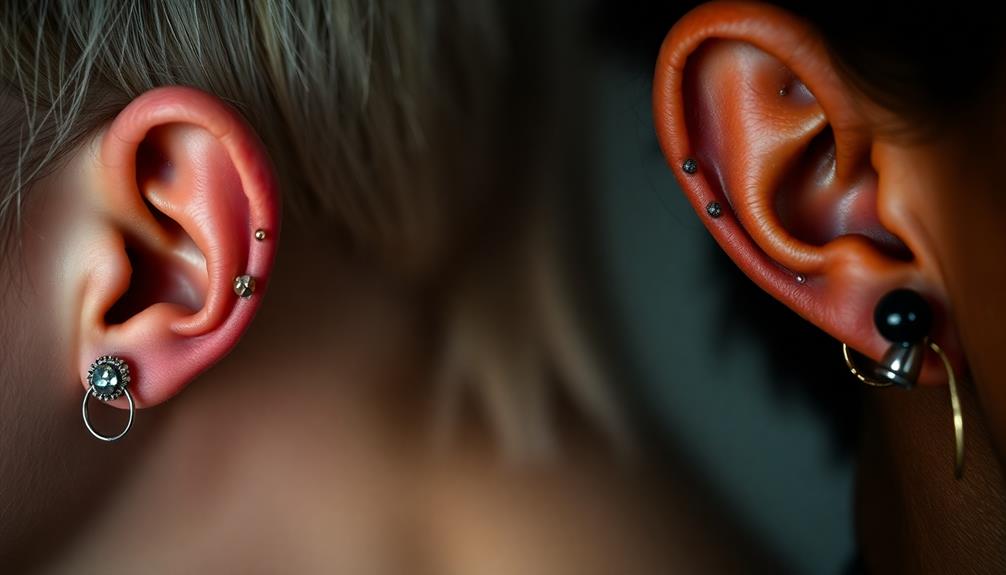
How do piercings influence your sense of self? For many, they serve as a powerful form of body modification, enhancing self-esteem and reshaping body image. Certain piercings, such as clitoral hood piercings, can enhance sexual pleasure, further contributing to a positive self-image.
When you choose to get pierced, you reclaim control over your body, allowing for a unique expression of identity. This act can symbolize a rebellion against societal norms, reinforcing your autonomy and self-identity.
Piercings can also act as a coping mechanism for emotional pain or trauma. They provide a tangible way to mark personal achievements and milestones, helping you navigate complex feelings.
The healing process associated with piercings often holds emotional significance, especially for those dealing with dysphoria. For transgender and non-binary individuals, this journey can be transformative, aiding in the exploration of gender identity and self-expression.
Personal narratives surrounding piercings frequently highlight these psychological impacts. They emphasize how the experience can lead to a deeper understanding of oneself, fostering confidence and resilience.
Ultimately, piercings are more than just adornments; they play a vital role in shaping how you perceive and express your identity in a world that often imposes limitations.
Community Bonding Through Body Modifications
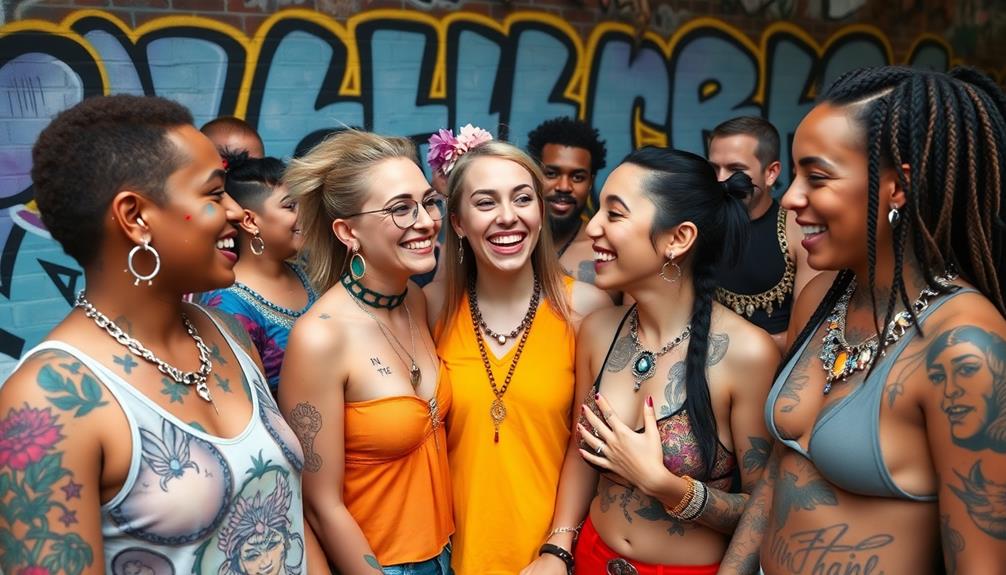
Many find that piercings create a sense of belonging within the LGBTQ+ community, serving as a shared expression of identity and solidarity.
When you engage in body modification through getting pierced, you're not just altering your appearance; you're participating in a communal ritual that fosters connections with others who value self-expression and defy societal norms.
Here are three ways piercings enhance community bonding:
- Shared Experiences: Group piercings often become memorable milestones, reinforcing friendships and creating a sense of shared identities among participants.
- Symbol of Resistance: Many see piercings as a collective stance against traditional gender presentations, promoting inclusivity and acceptance within diverse communities.
- Personal Journeys: For many in the queer community, getting pierced signifies important steps in their journeys of self-discovery, enhancing feelings of belonging and solidarity.
Gender Affirmation and Body Image
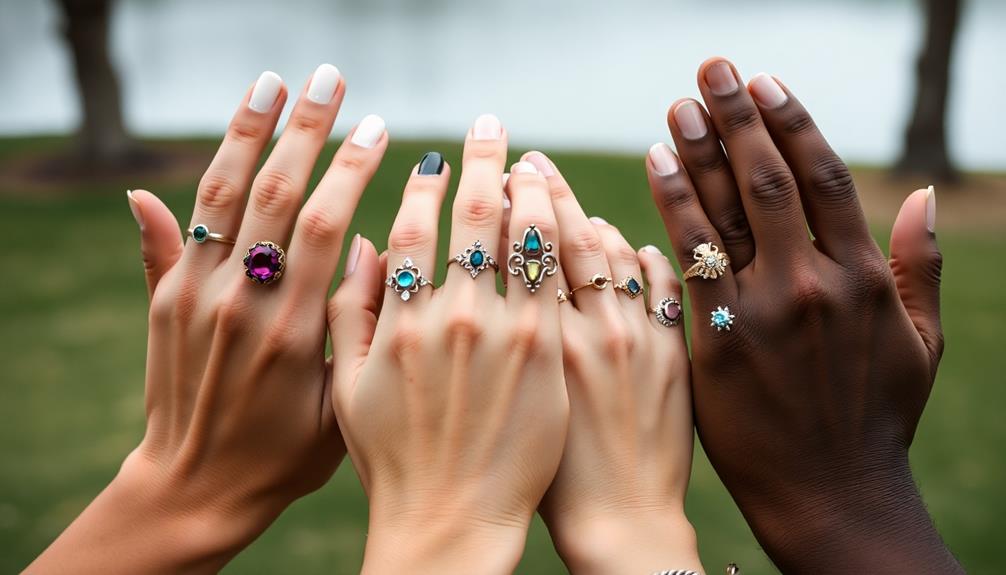
What role do piercings play in shaping your body image and affirming your gender identity? For many, piercings serve as significant forms of body modification that enhance self-acceptance and confidence.
In the transgender and non-binary communities, piercings can align your physical appearance with your gender identity, acting as a powerful tool for gender affirmation.
Consider how nipple and clitoral hood piercings can deepen your connection to your body, while Prince Albert piercings might help redefine your urinary function to match your identity.
For transgender men, large gauge labia piercings can be a tangible reminder of male anatomy, offering a non-surgical alternative for gender expression.
The emotional benefits of these modifications are profound. By choosing piercings, you reclaim your identity and improve your body image, fostering a stronger sense of self.
Plus, the accessibility and cost-effectiveness of piercings make them a viable option for those who may not pursue surgeries.
Ultimately, embracing piercings can transform your journey of gender affirmation, boosting your confidence and helping you express your true self.
Frequently Asked Questions
What Do Piercings Symbolize?
Piercings symbolize individuality and self-expression. They can represent personal milestones, defiance against norms, or a connection to communities. Each piercing tells a unique story, reflecting your journey and choices in life.
How Do Piercings Express Individuality?
Piercings express your individuality by showcasing your unique tastes and personality. Each choice, from location to jewelry style, reflects your values and experiences, allowing you to stand out and communicate who you truly are.
What Is the Psychology Behind Piercings?
The psychology behind piercings often revolves around self-empowerment and identity. You might use them to reclaim your body, express emotions, or mark milestones, finding a sense of belonging and boosting your self-esteem through personal choices.
What Is the Cultural Significance of Piercings?
Did you know that 83% of people believe piercings carry cultural significance? They often symbolize individuality, status, or tradition across various societies, reflecting personal beliefs and histories while connecting individuals to their cultural roots and communities.
Conclusion
In exploring the role of piercings in gender expression, it's clear they serve as powerful identity symbols. Some might argue that piercings are merely trends, but their cultural significance and personal meanings often run much deeper. For many, these body modifications affirm their gender identity and foster a sense of belonging within communities. By embracing piercings, individuals can challenge societal norms and express their authentic selves, showcasing the profound impact of these choices on one's identity journey.
Hi, my name is Danielle, and I’m an author for piercings-body.com. I have a passion for writing and love to share my knowledge on all things body piercing-related. I’m also a huge advocate for safe body modification practices and believe everyone should be able to make informed decisions about their bodies. When I’m not writing or blogging, I enjoy spending time with my family and friends, practicing yoga, and exploring new places.
Piercing and Wellness
Body Confidence and Piercings: Personal Stories and Insights
The journey of self-acceptance often intertwines with body piercings, revealing stories of transformation and empowerment that await your discovery.
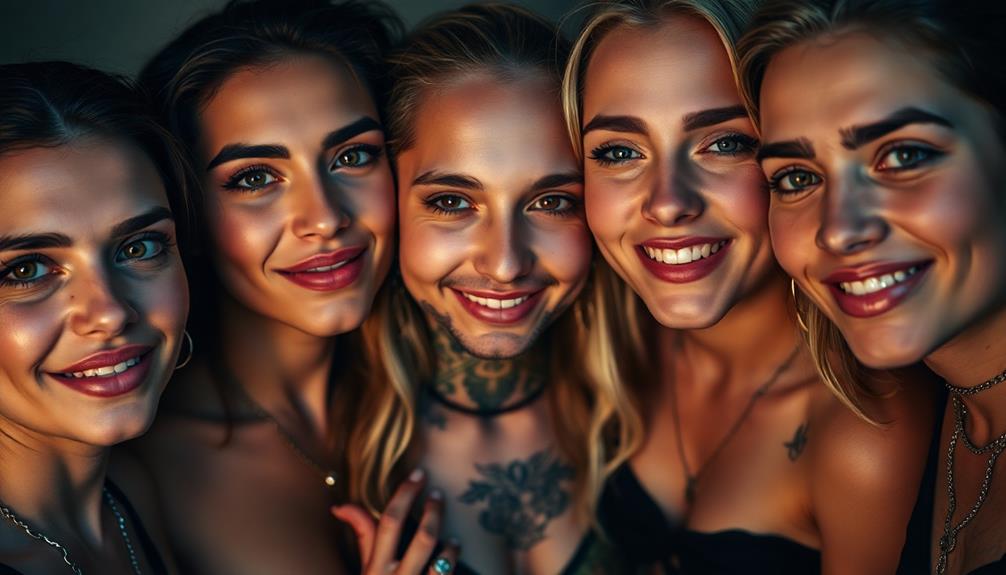
Body piercings can boost your confidence by allowing you to express who you are and mark significant moments in your life. Many people share stories of transformation linked to their piercings, celebrating milestones and personal growth. You might find that every piercing tells a story of resilience or empowerment, connecting you to a community that embraces individuality. While societal stigma around piercings persists, more people are redefining beauty standards and gaining confidence through body art. If you explore further, you'll discover deeper insights and personal experiences that can inspire your own journey of self-acceptance.
Key Takeaways
- Body piercings carry cultural significance, representing rites of passage and personal milestones across various civilizations.
- Many individuals find empowerment through piercings, which boost self-esteem and symbolize personal growth and resilience.
- Social stigma surrounding piercings is diminishing, with younger generations embracing body modifications as forms of self-expression.
- Health and safety are crucial; choosing licensed studios and practicing aftercare help minimize risks associated with piercings.
- The rise of body positivity movements encourages diverse expressions of beauty, linking body modifications to improved self-esteem and confidence.
Historical Significance of Piercings
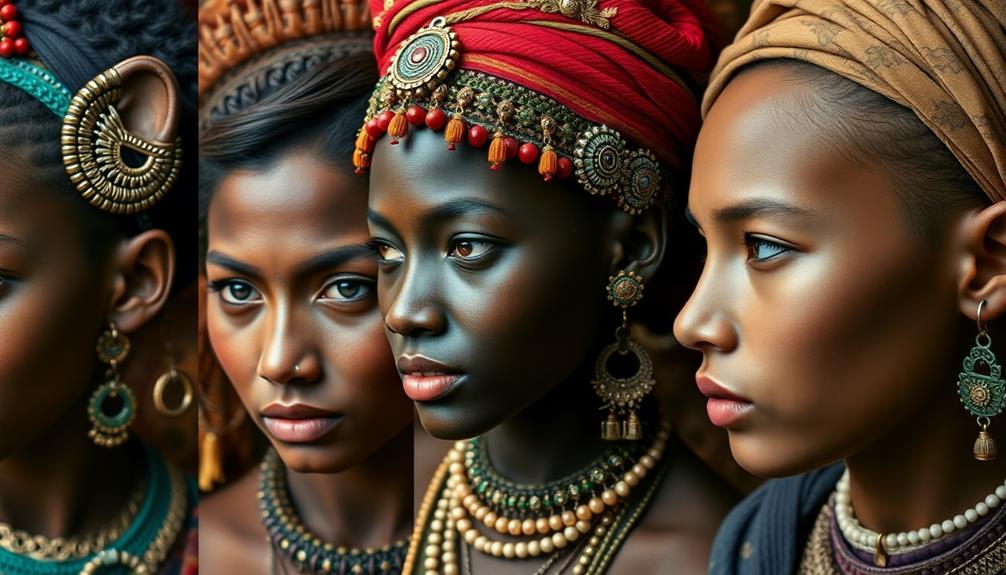
Throughout history, body piercings have held deep cultural significance across various civilizations. Ancient practices reveal that body modification, like piercing, often marked a rite of passage, signaling important changes in one's life.
For instance, in Egyptian culture, piercing was a symbol of nobility, while Aztec warriors displayed their bravery through elaborate ear piercings. These actions weren't just fashion statements; they were ingrained in the societal fabric, reflecting status and identity.
In many indigenous cultures, piercings indicated group affiliation and were used during significant ceremonies, reinforcing community bonds. As you explore these rich traditions, it's clear that piercings serve more than an aesthetic purpose; they connect you to your ancestry and cultural heritage.
The evolution of body piercing practices mirrors broader societal changes, shifting from sacred rituals to modern expressions of individuality.
Today, while mainstream acceptance has grown, the historical significance of piercings continues to influence how we perceive body modification. Understanding this history can deepen your appreciation of body art and its enduring role in shaping identity, making each piercing a personal homage to the past and a statement of who you're today.
Personal Empowerment Through Body Art
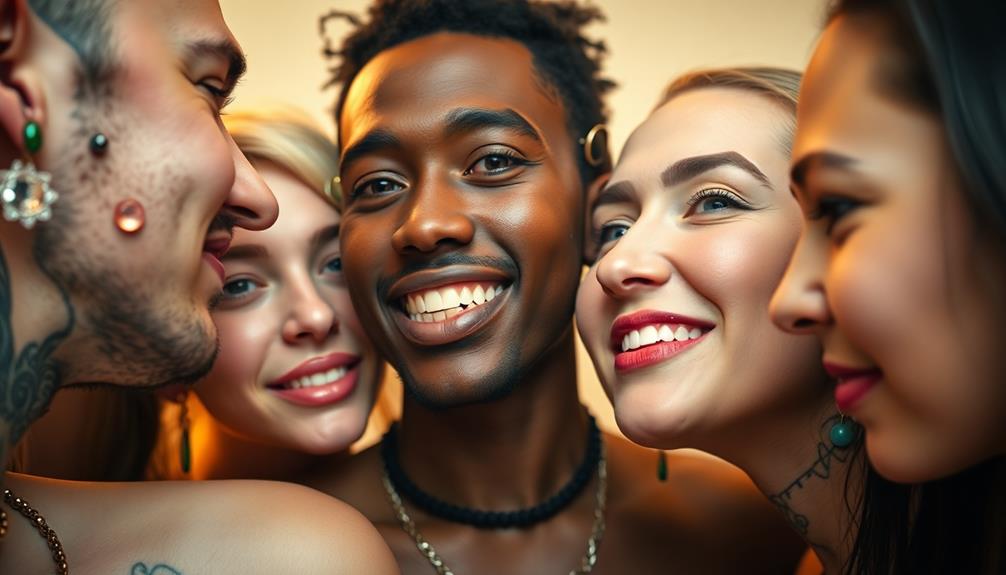
Body piercings let you express your individuality and mark significant moments in your life.
When you choose to adorn your body, you're taking control and celebrating your unique journey.
This empowerment can boost your confidence and help you connect with others who share your values and experiences.
Individual Expression Unleashed
When you choose to get a piercing, you're not just adding jewelry; you're making a bold statement about who you are. Body piercings serve as a powerful form of individual expression, revealing your unique identity and personal stories. Each piercing reflects a piece of your journey, allowing you to showcase your style and personality.
Research shows that people with piercings often experience increased confidence and self-esteem. You might find that your body modifications enhance your sense of individuality and serve as a declaration of autonomy. In a world that often pushes conformity, getting a piercing challenges societal norms and beauty standards, giving you the freedom to express yourself creatively.
Many personal stories highlight transformative moments tied to body piercings. These experiences often represent reclaiming your body and asserting your identity. Whether it's a small stud or an elaborate design, each piercing can signify a chapter in your life, a mark of personal empowerment.
Embracing body art like piercings allows you to connect with communities or subcultures that resonate with your values, reinforcing your sense of belonging and self-worth. Ultimately, it's about celebrating who you're and embracing your journey.
Symbolic Life Milestones
Empowerment often comes in unexpected forms, and for many, body piercings represent significant life milestones. These piercings serve as symbolic markers of your journey, celebrating achievements and changes. Whether it's a coming-of-age ritual, a personal victory, or a transformative experience, each piercing can act as a powerful form of self-expression.
In various cultures, piercings signify important life changes, like entering adulthood or embracing a new spiritual path. When you choose to get a piercing, you're making a statement about who you're and what you've overcome. Many individuals share how these body modifications help reclaim control over their bodies, allowing them to express their identity more fully.
Social media is filled with personal stories that highlight the emotional connection to piercings. They often commemorate important events or milestones that shaped who you're today. This connection can enhance your self-confidence, as each piece of body art tells a unique story, reflecting your growth and resilience.
Ultimately, piercings can empower you, reminding you of your journey and the strength you possess as you navigate life's challenges.
Emotional Impact of Piercings
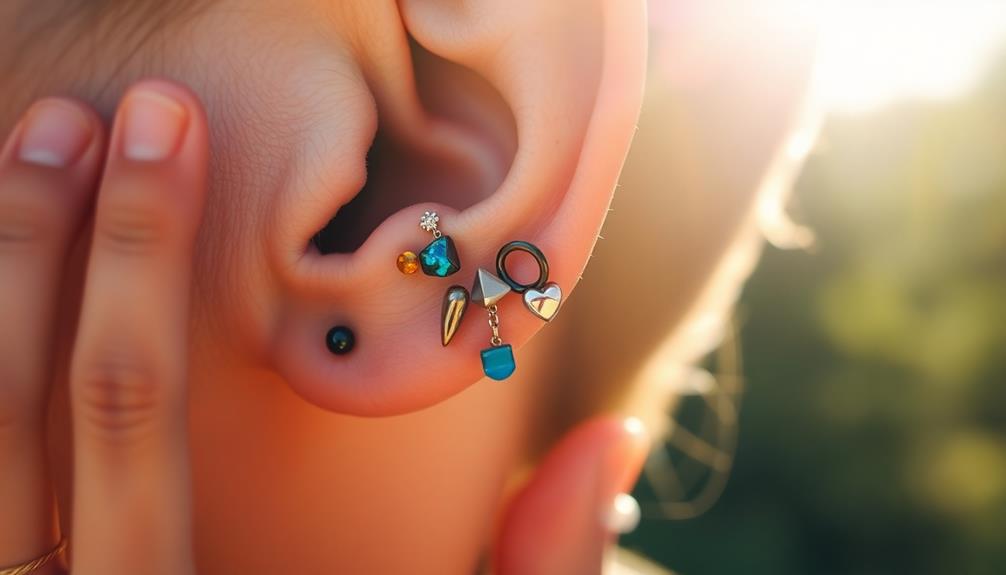
Piercings can be more than just adornments; they often become powerful symbols of self-expression and personal growth. For many, body modification like piercings enhances self-empowerment, allowing you to showcase your unique identity. You might find that each piercing tells a story, representing personal achievements or significant life events that contribute to your narrative.
Emotional connections to your piercings can run deep. They might serve as reminders of overcoming challenges or milestones in your life, boosting your self-esteem and body image satisfaction. Research shows that engaging in body modification can improve your overall emotional well-being, making you feel more comfortable in your skin.
For some, piercings act as coping mechanisms, offering solace during tough times. The act of modifying your body can give you a sense of control, helping to alleviate emotional pain.
Additionally, having piercings can foster a sense of belonging within specific communities, reinforcing a positive self-perception. Ultimately, each piercing can profoundly impact your emotional landscape, encouraging you to embrace who you're and celebrate your journey.
Cultural Perspectives on Body Modification
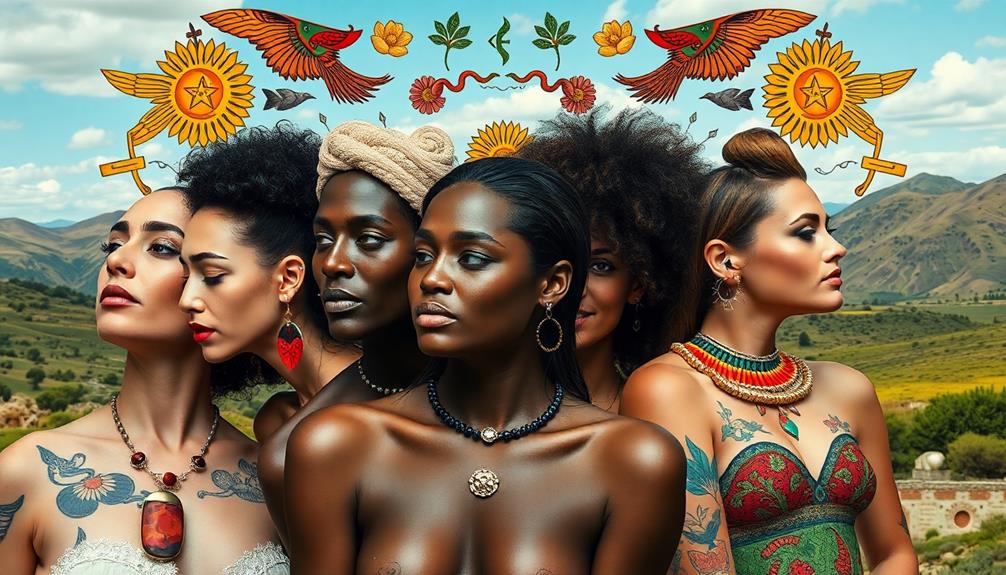
Throughout history, body modification, including piercings, has been a significant aspect of cultural identity and expression. You might find it fascinating how different cultures perceive piercings, varying from sacred rituals to forms of rebellion. For instance, ancient civilizations often used piercings in rites of passage, marking social status and identity. In contrast, contemporary Western societies may sometimes associate them with non-conformity.
As piercings gain popularity, they also reflect broader cultural dialogues about self-expression. Celebrities and social media influencers have propelled this trend, normalizing piercings as a mainstream form of body art. This has led to a blend of traditional and modern practices, showcasing a rich tapestry of cultural perspectives on body modification.
Here's a table summarizing these differences:
| Cultural Viewpoint | Example of Body Modification |
|---|---|
| Sacred or Spiritual | Indigenous tribal piercings |
| Rite of Passage | African lip plates |
| Rebellion or Non-Conformity | Punk rock ear piercings |
| Self-Expression | Modern cartilage piercings |
Navigating Social Stigma

Maneuvering social stigma around body piercings can be challenging, especially when you find yourself in environments that prioritize traditional appearances. In professional settings, visible piercings might lead to biased perceptions about your character and reliability. You may face assumptions that label you as rebellious or non-conformist, impacting your social interactions and opportunities.
This stigma can create emotional distress, much like the effects of narcissistic abuse recovery, making it crucial to develop resilience in the face of judgment.
However, it's important to recognize that societal attitudes are shifting. As younger generations increasingly accept body modification, the stigma surrounding piercings is gradually diminishing. This growing acceptance can empower you to embrace your piercings as a means of personal expression and self-confidence, despite the judgments you might encounter.
Cultural differences further complicate the landscape of addressing stigma. While some societies celebrate body modification, others impose strict norms that can make you feel ostracized. Understanding these variations can help you frame your experience positively.
Ultimately, you have the power to redefine what your piercings mean to you, using them as a tool for self-assertion rather than allowing stigma to dictate your worth. Embrace your journey, and remember that confidence often shines brighter than societal judgment.
Health and Safety Considerations
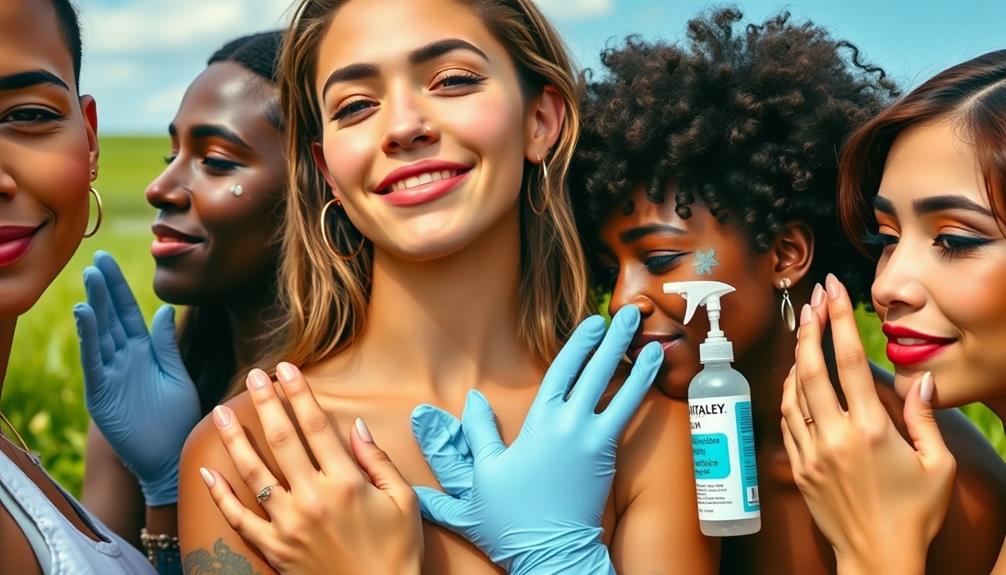
When it comes to body piercings, prioritizing health and safety is essential for a positive experience. You need to choose a licensed and reputable piercing studio, especially since there are only 12 licensed studios in Erie County. A professional piercer will use sterile equipment, like single-use needles, to minimize potential risks like tissue damage and contamination.
Additionally, understanding the importance of piercing care and hygiene can help you maintain your new piercing effectively. Proper aftercare is vital. Clean your piercing with saline solution and avoid touching it with unwashed hands. This helps reduce the risk of infections and complications. Regularly monitor the piercing site for signs of infection, such as redness, swelling, or unusual discharge, so you can seek timely treatment if needed.
Allergic reactions to jewelry materials, like nickel, can occur, especially for those with sensitive skin. Opting for hypoallergenic options is a wise choice to avoid discomfort.
Stories of Transformation

Many people find that their first piercing experience is more than just a cosmetic change; it often marks a pivotal moment in their journey toward body confidence and self-acceptance.
For many, a piercing symbolizes empowerment, especially after overcoming personal challenges like a divorce or loss. As you navigate these emotional changes, the importance of acknowledging feelings becomes clear; you may reclaim control over your body and identity through this transformative act, firmly establishing your individuality.
Personal stories frequently reveal how these body art choices enhance self-esteem and body image. When you choose a specific piercing, it becomes a unique representation of who you are, reflecting your evolving identity.
Emotional connections often emerge, as you associate certain piercings with important milestones in your life. This connection deepens your appreciation for your body and the personal narrative tied to each mark.
Accounts from others highlight the profound impact piercings have on personal growth. Each piece of body art serves as a visual representation of your journey, showcasing resilience and change.
Trends in Piercing Practices
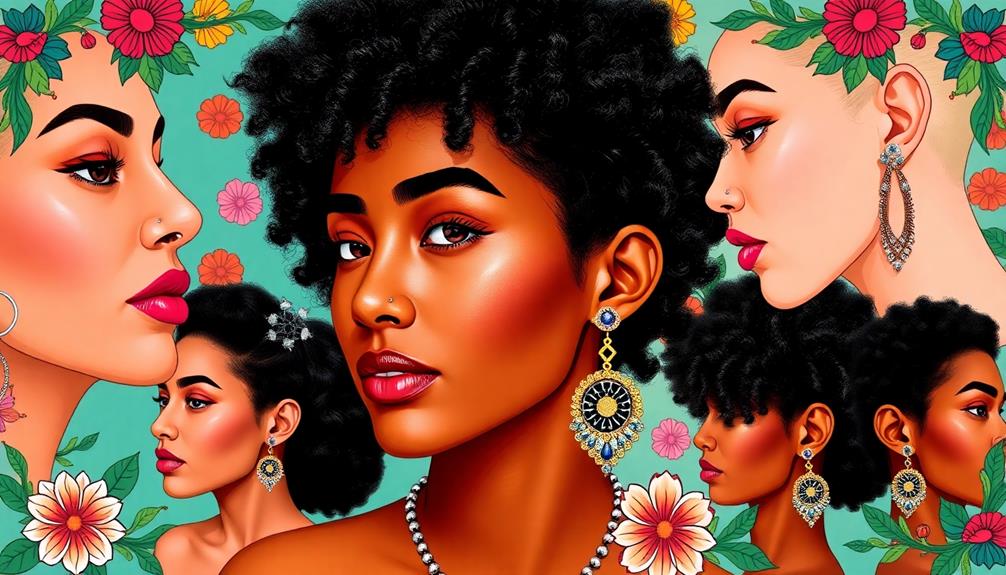
When it comes to popular piercing styles today, you're likely to see a mix of traditional and non-traditional options gaining traction.
Cultural influences play a big role in shaping these trends, with social media showcasing unique placements like septum and daith piercings.
As you explore these evolving practices, you might find new ways to express your identity through body art.
Popular Piercing Styles
There's no denying that piercing styles have evolved dramatically over the years, reflecting personal expression and cultural trends. Ear piercings remain the most common form, with options like lobe, cartilage, tragus, and industrial bar becoming increasingly popular.
You're likely to see people experimenting with multi-piercing configurations that showcase their unique style and creativity.
Facial piercings have also surged in acceptance, particularly among younger demographics. Nostril, septum, and lip piercings are now seen as fashionable statements rather than taboo choices.
Whether you're considering a single lip piercing or a more complex arrangement, the options are endless.
Belly button piercings, too, have gained popularity, especially among teen girls. They symbolize a mix of personal expression and current fashion trends, often becoming a must-have accessory for summer outfits.
With social media playing a significant role, you can find countless inspiration for your next piercing.
As professional piercing studios pop up everywhere, it's easier than ever to explore these styles.
No matter what you choose, the key is to embrace your individuality and let your piercings reflect who you are.
Cultural Influences Today
As piercing styles continue to evolve, cultural influences today play a pivotal role in shaping trends and practices. You might notice that the average number of piercings per individual has risen to 11, reflecting how body modification has become a popular form of personal expression.
Social media and celebrity endorsements are driving this trend, leading to increased interest in non-traditional placements and unique designs.
Around 62% of people choose to get piercings primarily for self-expression, highlighting a societal shift toward individuality and empowerment. The rise of surface anchors and innovative body art showcases a growing desire for distinctiveness, allowing you to express your personality in creative ways.
Cultural acceptance of body piercings has also surged, with various subcultures embracing diverse styles, making piercings a mainstream form of self-adornment.
This acceptance means you can confidently explore your body and its adornments without fearing judgment. As you consider your next piercing, remember that it's not just about aesthetics; it's about embracing your identity and celebrating the cultural evolution surrounding body art today.
Future of Body Confidence and Piercings

The future of body confidence and piercings looks bright, with increasing societal acceptance fueling a revolution in self-expression. As social media and celebrity endorsements pave the way, more people are embracing body modification as a form of identity and empowerment.
This trend mirrors the growing need for individuals to find balance in their personal lives, akin to the importance of balancing career and personal life in fostering healthy relationships. You might find that non-traditional piercings and unique placements become more popular, reflecting a shift away from conventional beauty standards.
Body positivity movements are gaining traction, advocating for the celebration of diverse body types and styles. This shift fosters a broader acceptance of piercings, which many see as symbols of personal power and individuality.
Research indicates that individuals with piercings often report improved self-esteem and body image satisfaction, suggesting a positive psychological impact that shapes attitudes toward body modifications.
As awareness of health risks associated with body art practices grows, you're likely to notice a trend toward seeking reputable piercing studios. This informed decision-making process not only enhances your piercing experience but also nurtures a culture of safety and confidence in body modifications.
Embracing this future means you can express your uniqueness while feeling empowered and secure in your choices.
Frequently Asked Questions
Do Piercings Make You More Confident?
Absolutely, piercings can boost your confidence. They allow you to express your individuality and create a unique identity. When you feel good about your appearance, it often translates into increased self-esteem and empowerment in your daily life.
What Is the Psychological Reason for Body Piercing?
Did you know that 60% of people report feeling more confident after getting a piercing? This psychological boost often stems from the empowerment and individuality that body modifications provide, helping you express your unique identity.
What Are the Social Impacts of Body Piercings?
Body piercings can enhance your social identity, signaling affiliation with specific groups and shared values. They foster connections and create personal narratives, while also influencing how others perceive you in both social and professional environments.
What Do Piercings Symbolize?
Piercings are like badges of honor, each one telling a story. They symbolize personal empowerment, individuality, and a journey of self-discovery. You wear them proudly, expressing your unique identity and challenging societal norms.
Conclusion
In embracing body piercings, you're not just altering your appearance; you're weaving a tapestry of self-expression and empowerment. Just like a butterfly emerging from its cocoon, each piercing can symbolize your transformation and newfound confidence. By understanding the historical, cultural, and emotional layers behind body art, you can navigate its complexities with pride. As trends evolve, remember that your body is your canvas, and every choice you make adds to your unique story of self-acceptance.
Hi, my name is Danielle, and I’m an author for piercings-body.com. I have a passion for writing and love to share my knowledge on all things body piercing-related. I’m also a huge advocate for safe body modification practices and believe everyone should be able to make informed decisions about their bodies. When I’m not writing or blogging, I enjoy spending time with my family and friends, practicing yoga, and exploring new places.
-

 Piercing Industry Insights3 weeks ago
Piercing Industry Insights3 weeks agoThe Economics of Running a Successful Piercing Studio
-

 Piercing Industry Insights3 weeks ago
Piercing Industry Insights3 weeks agoFamous Body Piercers and Their Signature Styles
-

 Beginners Guides3 weeks ago
Beginners Guides3 weeks agoExplore Varied Cartilage Earring Styles
-

 Unique Piercing Contexts3 weeks ago
Unique Piercing Contexts3 weeks agoPiercings in Prison: Regulations, Methods, and Meanings
-

 Advanced Piercing Techniques3 weeks ago
Advanced Piercing Techniques3 weeks agoAdvanced Aftercare for Complex Piercings
-

 Advanced Piercing Techniques3 weeks ago
Advanced Piercing Techniques3 weeks agoThe Role of Anatomy in Successful Piercings
-

 Advanced Piercing Techniques3 weeks ago
Advanced Piercing Techniques3 weeks agoPiercing Stretching Techniques: From Standard to Tapering
-

 Piercing Industry Insights3 weeks ago
Piercing Industry Insights3 weeks agoEthical Considerations in Body Modification: a Piercer’s Responsibility










